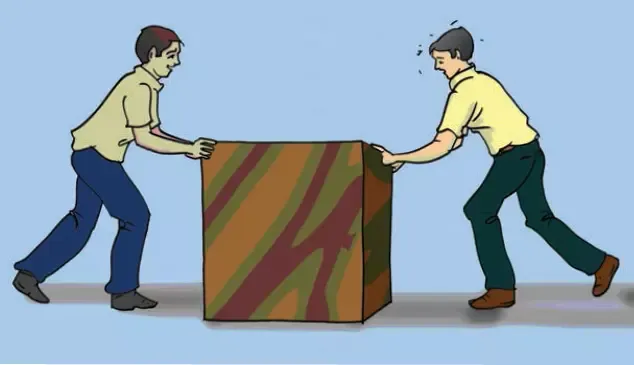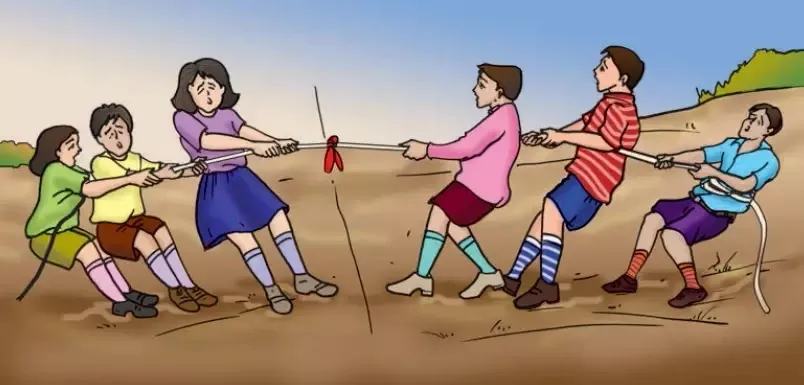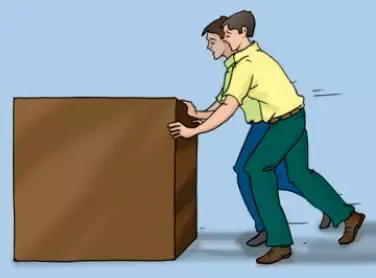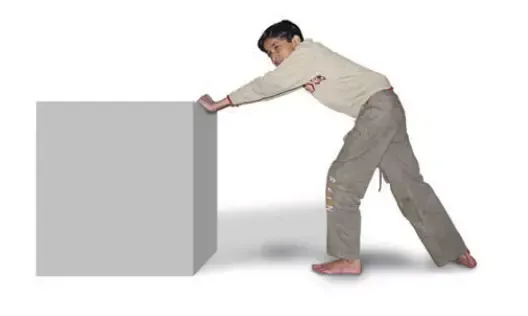Chapter 12 - Friction
Multiple Choice Questions
Question 1: Whenever the surfaces in contact tend to move or move with respect to each other, the force of friction comes into play
a) only if the objects are solid.
b) only if one of the two objects is liquid.
c) only if one of the two objects is gaseous.
d) irrespective of whether the objects are solid, liquid or gaseous.
Answer: d) irrespective of whether the objects are solid, liquid or gaseous.
Question 2:
In Fig.12.1, a boy is shown pushing the box from right to left. The force of friction will act on the box
a) from right to left (←)
b) from left to right (→)
c) vertically downwards (↓)
d) vertically upwards (↑)
Answer: b) from left to right (→)
Question 3: To sharpen the blade of a knife by rubbing it against a surface, which of the following will be most suitable?
a) stone
b) plastic block
c) wooden block
d) glass block
Answer: a) stone
Question 4: A toy car released with the same initial speed will travel farthest on
a) muddy surface
b) polished marble surface
c) cemented surface
d) brick surface
Answer: c) cemented surface
Question 5: If we apply oil on door hinges, the friction will
a) increase
b) decrease
c) disappear altogether
d) will remain unchanged
Answer: b) decrease
Question 6: Which of the following statements is incorrect?
a) Friction acts on a ball rolling along the ground.
b) Friction acts on a boat moving on water.
c) Friction acts on a bicycle moving on a smooth road.
d) Friction does not act on a ball moving through air.
Answer: d) Friction does not act on a ball moving through air.
Question 7: A boy rolls a rubber ball on a wooden surface. The ball travels a short distance before coming to rest. To make the same ball travel longer distance before coming to rest, he may
a) spread a carpet on the wooden surface.
b) cover the ball with a piece of cloth.
c) sprinkle talcum powder on the wooden surface.
d) sprinkle sand on the wooden surface.
Answer: c) sprinkle talcum powder on the wooden surface.
Question 8: In a large commercial complex there are four ways to reach the main road. One of the path has loose soil, the second is laid with polished marble, the third is laid with bricks and the fourth has gravel surface. It is raining heavily and Paheli wishes to reach the main road. The path on which she is least likely to slip is
a) loose soil.
b) polished marble.
c) bricks.
d) gravel.
Answer: d) gravel.
Very Short Answer Questions
Question 9: Two blocks of iron of different masses are kept on a cemented floor as shown in Fig.12.2. Which one of them would require a larger force to move it from the rest position?
Answer: The second block of iron would require a larger force to move it from the rest position because friction is more if the surfaces are pressed harder.
Question 10: Will force of friction come into play when a rain drop rolls down a glass window pane?
Answer: Yes, force of friction will come into play when a rain drop rolls down a glass window pane because force of friction is the force which opposes the motion of an object over a surface. The force of friction acts between the object and the surface. Here the object is rain drop while the glass window pane is the surface.
Question 11: Two boys are riding their bicycles on the same concrete road. One has new tyres on his bicycle while the other has tyres that are old and used. Which of them is more likely to skid while moving through a patch of the road which has lubricating oil spilled over it?
Answer: The second boy who has the bicycle with worn out tyres is more likely to skid because the new bicycle has better grooves and hence can protect him from skidding.
Question 12: Fig.12.3 shows two boys applying force on a box. If the magnitude of the force applied by each is equal, will the box experience any force of friction?

Answer: The force applied by both the boys will cancel out each other and the resultant force will become zero. Therefore, the force of friction will be zero.
Question 13: Imagine that an object is falling through a long straight glass tube held vertical; air has been removed completely from the tube. The object does not touch the walls of the tube. Will the object experience any force of friction?
Answer: No, the object will not be subjected to any frictional force since the force of friction requires two surfaces, and there is only one in this case.
Short Answer Questions
Question 14: You might have noticed that when used for a long time, slippers with rubber soles become slippery. Explain the reason.
Answer: When rubber soles are used for a long time, their surfaces become smooth. Hence, the friction between the sole and the floor decreases. Therefore, slippers become slippery.
Question 15: Is there a force of friction between the wheels of a moving train and iron rails? If yes, name the type of friction. If an air cushion can be introduced between the wheel and the rail, what effect will it have on the friction?
Answer: Yes, there is a force of friction between the wheels of a moving train and iron rails. The type of friction that is present between them is rolling friction. If an air cushion is introduced between the wheel and the rails, the friction will decrease.
Question 16: Cartilage is present in the joints of our body, which helps in their smooth movement. With advancing age, this cartilage wears off. How would this affect the movement of joints?
Answer: The wearing off of cartilage will increase the friction. As a result the movement of joints will become difficult which may lead to joint pains.
Question 17: While playing tug of war (Fig.12.4), Preeti felt that the rope was slipping through her hands. Suggest a way out for her to prevent this.

Answer: Preeti can rub soil to increase friction between the rope and her hand.
Question 18: The handle of a cricket bat or a badminton racquet is usually rough. Explain the reason.
Answer: The handles of a cricket bat or a badminton racquet is usually rough so that the player can easily grip the cricket bat or badminton racquet.
Question 19: Explain why the surface of mortar and pestle (silbatta) used for grinding is etched again after prolonged use?
Answer: The surface of mortar and pestle (silbatta) used for grinding is etched again after prolonged use so as to increase the friction to make it more effective for grinding again.
Question 20: A marble is allowed to roll down an inclined plane from a fixed height. At the foot of the inclined plane, it moves on a horizontal surface (a) covered with silk cloth (b) covered with a layer of sand and (c) covered with a glass sheet. On which surface will the marble move the shortest distance. Give reason for your answer.
Answer: The marble will move the shortest distance on the surface covered with a layer of sand because if both the surfaces are rough then the friction will be more and friction opposes the motion of an object over a surface.
Question 21: A father and son pushed their car to bring it to the side of road as it had stalled in the middle of the road. They experienced that although they had to push with all their might initially to move the car, the push required to keep the car rolling was smaller, once the car started rolling. Explain.
Answer: At the beginning, the father and son had to use larger force because static friction was present. But as the car slowly started to move they had to apply lesser force because the surface contact is least which results in less friction on the road. And therefore, they found it easier to push after sometime.
Long Answer Questions
Question 22: When the cutting edge of a knife is put against a fast rotating stone to sharpen it, sparks are seen to fly. Explain the reason.
Answer: The friction is produced when the 2 surfaces are in contact. Here, the edge of knife and stone are in contact. Vigorously touching of the grinding stone and cutting edge of a knife together for a few minutes can produce heat and after a few minutes we get to see the sparks flying because here the friction is very large in this case so the large amount of heat is produced.
Question 23: We have two identical metal sheets. One of them is rubbed with sand paper and the other with ordinary paper. The one rubbed with sand paper shines more than the other. Give reason.
Answer: The friction between sand paper and metal sheet is very large, compared to that between the ordinary paper and the metal sheet. Thus the sand paper is able to remove the outer dull layer from the metal sheet more effectively and makes it more shining.
Question 24: While travelling on a rickshaw, you might have experienced that if the seat cover is very smooth, you tend to slip when brakes are applied suddenly. Explain.
Answer: We tend to slip when brakes are applied suddenly on rickshaw if the seat cover is very smooth because the friction present is less on a smooth surface. The contact between the seat and us is less. And therefore, we tend to slip when break is applied suddenly.
Question 25: Two friends are trying to push a heavy load as shown in Fig.12.5. Suggest a way which will make this task easier for them.

Answer: They can put rollers or wheels below the heavy load because the rolling friction is smaller than the sliding friction. In the rolling friction, they have to apply lesser force because in rolling friction, the surface contact is least which results in less friction on the floor.


No comments:
Post a Comment